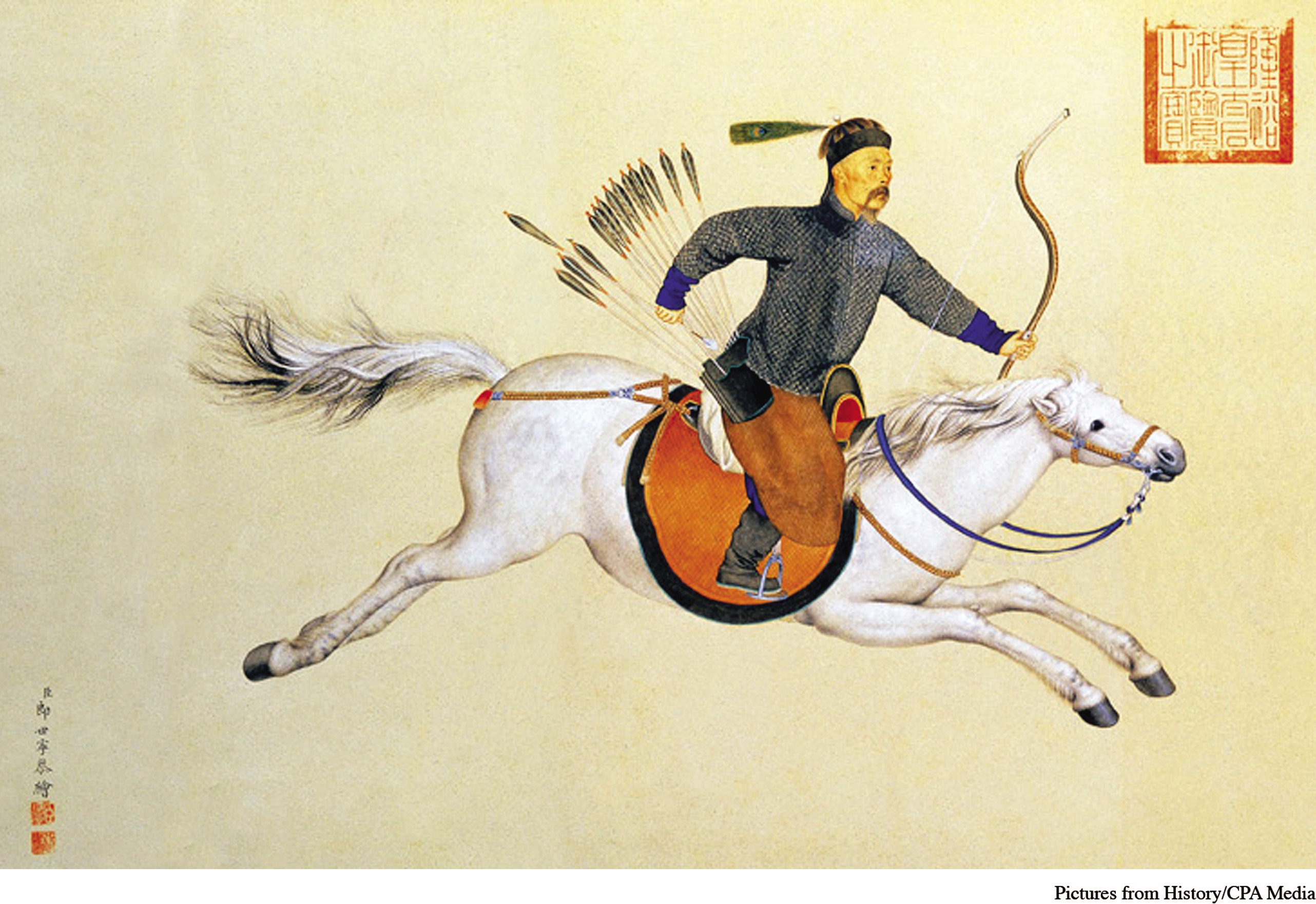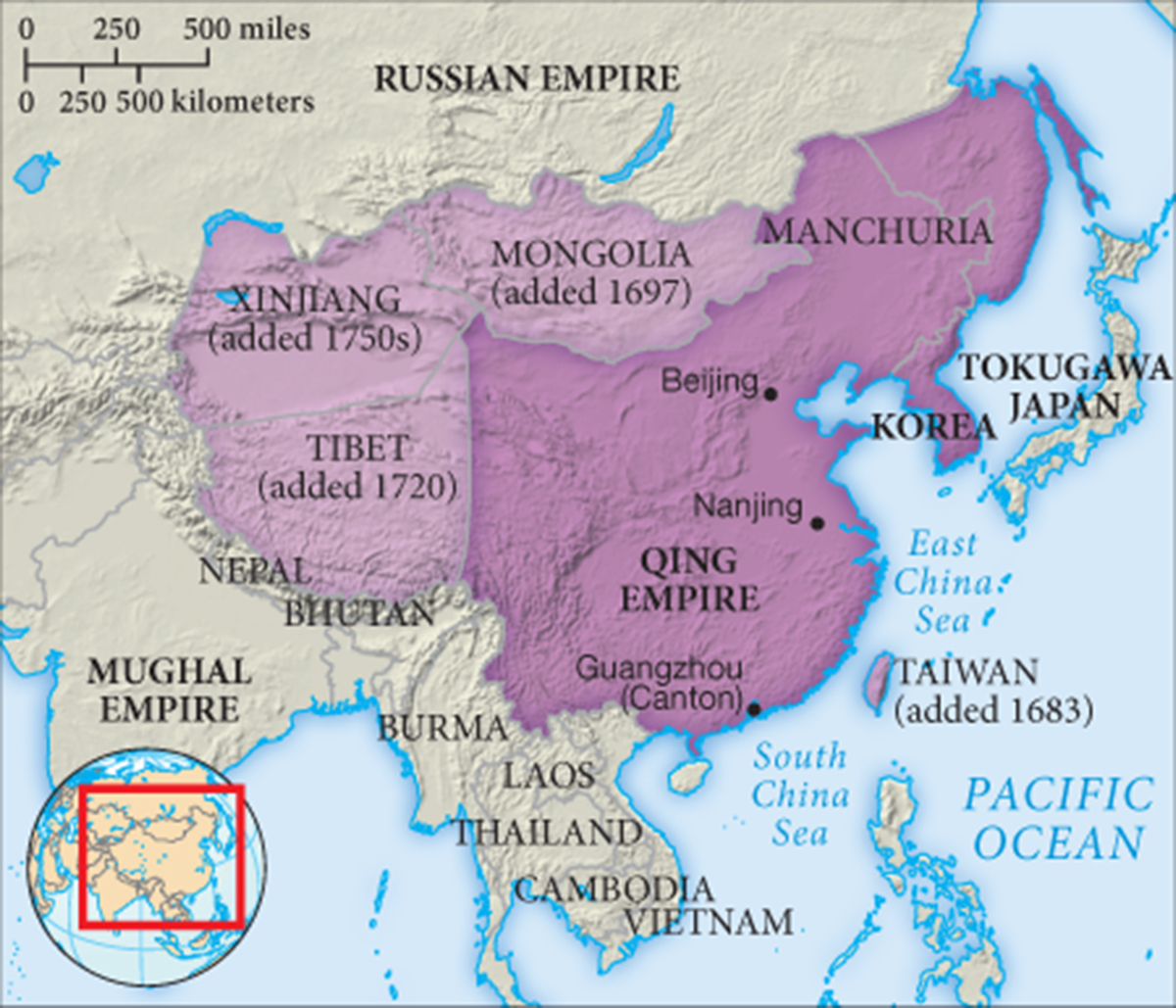Making China an Empire
In the fifteenth century, China had declined an opportunity to construct a maritime empire in the Indian Ocean, as Zheng He’s massive fleet was withdrawn and left to wither away (see “Ming Dynasty China” in Chapter 12). In the seventeenth and eighteenth centuries, however, China built another kind of empire on its northern and western frontiers that vastly enlarged the territorial size of the country and incorporated a number of non-Chinese peoples. Undertaking this enormous project of imperial expansion was China’s Qing, or Manchu, dynasty (1644–1912). Strangely enough, the Qing dynasty was itself of foreign and nomadic origin, hailing from Manchuria, north of the Great Wall. Having conquered China, the Qing rulers sought to maintain their ethnic distinctiveness by forbidding intermarriage between themselves and the Chinese. Nonetheless, their ruling elites also mastered the Chinese language and Confucian teachings and used Chinese bureaucratic techniques to govern the empire. Perhaps because they were foreigners, Qing rulers went to great lengths to reinforce traditional Confucian gender roles, honoring men who were loyal sons, officials, and philanthropists and women who demonstrated loyalty to their spouses by resisting rape or remaining chaste as widows.
What were the distinctive features of Chinese empire building in the early modern era?
For many centuries, the Chinese had interacted with the nomadic peoples, who inhabited the dry and lightly populated regions now known as Mongolia, Xinjiang, and Tibet. Trade, tribute, and warfare ensured that these ecologically and culturally different worlds were well known to each other, quite unlike the New World “discoveries” of the Europeans. Chinese authority in the area had been intermittent and actively resisted. Then, in the early modern era, Qing dynasty China undertook an eighty-year military effort (1680–1760) that brought these huge regions solidly under Chinese control. It was largely security concerns, rather than economic need, that motivated this aggressive posture. During the late seventeenth century, the creation of a substantial state among the western Mongols, known as the Zunghars, revived Chinese memories of an earlier Mongol conquest. As in so many other cases, Chinese expansion was viewed as a defensive necessity. The eastward movement of the Russian Empire likewise appeared potentially threatening, but this danger was resolved diplomatically, rather than militarily, in the Treaty of Nerchinsk (1689), which marked the boundary between Russia and China.

Chinese Conquests in Central Asia Painted by the Chinese artist Jin Tingbiao in the mid-eighteenth century, this image portrays Machang, a leading warrior involved in the westward extension of the Chinese empire. The painting was commissioned by the emperor himself and served to honor the bravery of Machang. (Pictures from History/CPA Media)
Although undertaken by the non-Chinese Manchus, the Qing dynasty campaigns against the Mongols marked the evolution of China into a Central Asian empire. The Chinese, however, have seldom thought of themselves as an imperial power. Rather, they spoke of the “unification” of the peoples of central Eurasia within a Chinese state. Nonetheless, historians have seen many similarities between Chinese expansion and other cases of early modern empire building, while noting some clear differences as well.
Clearly the Qing dynasty takeover of central Eurasia was a conquest, making use of China’s more powerful military technology and greater resources. Furthermore, the area was ruled separately from the rest of China through a new office called the Court of Colonial Affairs. Like other colonial powers, the Chinese made active use of local notables—Mongol aristocrats, Muslim officials, Buddhist leaders—as they attempted to govern the region as inexpensively as possible. Sometimes these native officials abused their authority, demanding extra taxes or labor service from local people and thus earning their hostility. In places, those officials imitated Chinese ways by wearing peacock feathers, decorating their hats with gold buttons, or adopting a Manchu hairstyle that was much resented by many Chinese who were forced to wear it.
More generally, however, Chinese or Qing officials did not seek to assimilate local people into Chinese culture and showed considerable respect for the Mongolian, Tibetan, and Muslim cultures of the region. People of noble rank, Buddhist monks, and those associated with monasteries were excused from the taxes and labor service required of ordinary people. Nor was the area flooded with Chinese settlers. In parts of Mongolia, for example, Qing authorities sharply restricted the entry of Chinese merchants and other immigrants in an effort to preserve the area as a source of recruitment for the Chinese military. They feared that the “soft” and civilized Chinese ways might erode the fighting spirit of the Mongols.

Map 13.3 China’s Qing Dynasty Empire After many centuries of intermittent expansion into Central Asia, the Qing dynasty brought this vast region firmly within the Chinese empire.
The long-term significance of this new Chinese imperial state was tremendous. It greatly expanded the territory of China and added a small but important minority of non-Chinese people to the empire’s vast population (see Map 13.3). The borders of contemporary China are essentially those created during the Qing dynasty. Some of those peoples, particularly those in Tibet and Xinjiang, have retained their older identities and in recent decades have actively sought greater autonomy or even independence from China.
Even more important, Chinese conquests, together with the expansion of the Russian Empire, utterly transformed Central Asia. For centuries, that region had been the cosmopolitan crossroads of Eurasia, hosting the Silk Road trading network, welcoming all the major world religions, and generating an enduring encounter between the nomads of the steppes and the farmers of settled agricultural regions. Now under Russian or Chinese rule, it became the backward and impoverished region known to nineteenth- and twentieth-century observers. Land-based commerce across Eurasia increasingly took a backseat to oceanic trade. Indebted Mongolian nobles lost their land to Chinese merchants, while nomads, no longer able to herd their animals freely, fled to urban areas, where many were reduced to begging. The incorporation of inner Eurasia into the Russian and Chinese empires “eliminated permanently as a major actor on the historical stage the nomadic pastoralists, who had been the strongest alternative to settled agricultural society since the second millennium B.C.E.”27 It was the end of a long era.

